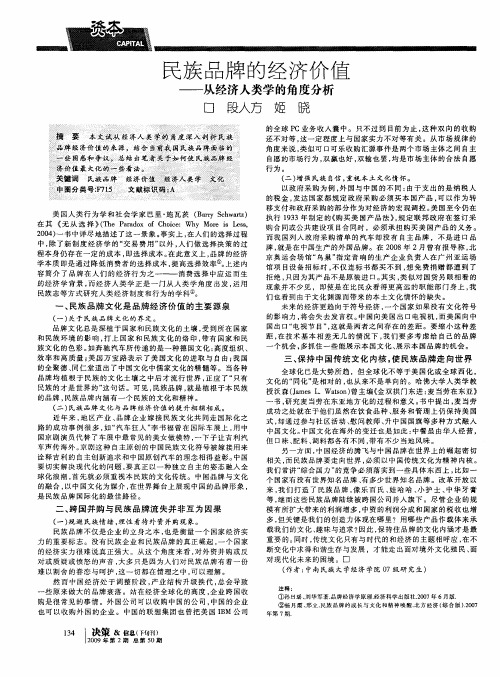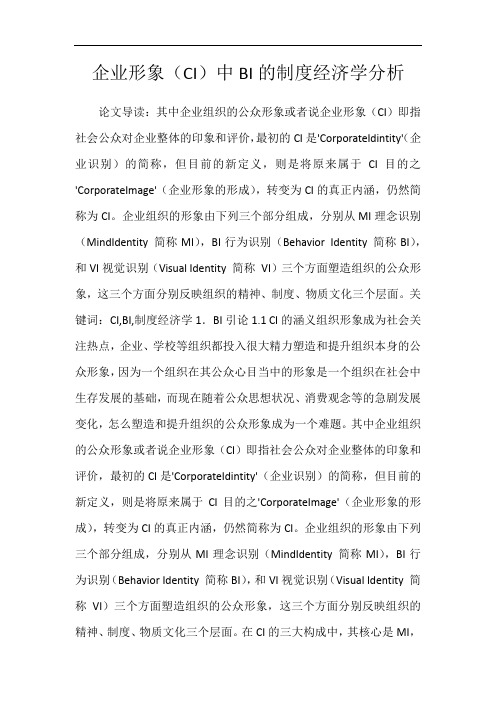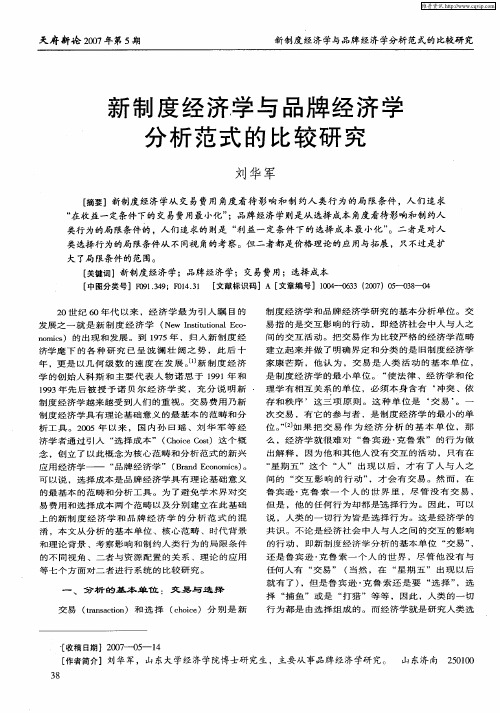品牌的制度经济学分析
民族品牌的经济价值——从经济人类学的角度分析

程 本 身 仍存 在 一定 的成 本 , 选择 成 本 。 此 意 义 上 , 牌 的经 济 即 在 品 学 本 质 即是 通 过 降低 消 费者 的选 择 成 本 , 高 选 择效 率 ① 上述 内 提 。 容 简介 了 品 牌 在 人 们 的经 济 行 为 之 一— — 消 费 选 择 中应 运 而 生 的 经 济 学 背 景 , 经 济 人 类 学 正 是 一 门从 人 类 学 角 度 出 发 , 用 而 运 民族 志 等 方 式 研 究人 类 经 济 制 度 和 行 为 的 学科 。
l 强 天憾 酶 一Байду номын сангаас漫 轰 法 蠢 § t § . §l § §
姬
晓
的 全球 P C业 务 收 入 囊 中。 只 不 过 到 目前 为 止 , 种 双 向 的 收 购 这 还 不 对 等 , 一 定 程 度 上 与 国家 实 力 不 对 等有 关 。从 市场 规律 的 这 角度 来 说 , 似 可 口可 乐 收购 汇 源 事 件 是 两个 市 场 主体 之 间 自主 类 自愿 的市 场 行 为 , 赢 也 好 , 输也 罢 , 是 市场 主体 的合 法 自愿 双 双 均
一
、
民族 品牌 文化 是 品牌经 济价值 的 主要源 泉
( ) 于 民族 品 牌 文 化 的界 定 。 一 关
品 牌 文 化 总 是深 植 于 国家 和 民族 文 化 的 土壤 , 到所 在 国家 受 和 民族 环境 的 影 响 , 上 国家 和 民族 文化 的 烙 印 , 有 国 家 和 民 打 带 族 文 化 的色 彩 。 奔 驰 汽 车所 传 递 的是 一 种 德 国 文化 : 如 高度 组 织 、 效 率 和 高质 量 ; 国 万 宝 路 表 示 了美 国文 化 的 进取 与 自 由 ; 国 美 我 的全 聚 德 、 同仁 堂道 出 了 中 国文 化 中儒 家 文 化 的 精 髓 等 。 当各 种 品牌 均 植 根 于 民族 的文 化 土壤 之 中 后 才 流 行 世 界 , 应 了“ 正 只有 民族 的才 是 世 界 的 ” 句 话 。可 见 , 这 民族 品 牌 , 是 植 根 于 本 民族 就 的 品牌 , 民族 品牌 内涵 有 一 个 民族 的 文化 和 精 神 。
企业形象(CI)中BI的制度经济学分析

企业形象(CI)中BI的制度经济学分析论文导读:其中企业组织的公众形象或者说企业形象(CI)即指社会公众对企业整体的印象和评价,最初的CI是'CorporateIdintity'(企业识别)的简称,但目前的新定义,则是将原来属于CI目的之'CorporateImage'(企业形象的形成),转变为CI的真正内涵,仍然简称为CI。
企业组织的形象由下列三个部分组成,分别从MI理念识别(MindIdentity 简称MI),BI行为识别(Behavior Identity 简称BI),和VI视觉识别(Visual Identity 简称VI)三个方面塑造组织的公众形象,这三个方面分别反映组织的精神、制度、物质文化三个层面。
关键词:CI,BI,制度经济学1.BI引论1.1 CI的涵义组织形象成为社会关注热点,企业、学校等组织都投入很大精力塑造和提升组织本身的公众形象,因为一个组织在其公众心目当中的形象是一个组织在社会中生存发展的基础,而现在随着公众思想状况、消费观念等的急剧发展变化,怎么塑造和提升组织的公众形象成为一个难题。
其中企业组织的公众形象或者说企业形象(CI)即指社会公众对企业整体的印象和评价,最初的CI是'CorporateIdintity'(企业识别)的简称,但目前的新定义,则是将原来属于CI目的之'CorporateImage'(企业形象的形成),转变为CI的真正内涵,仍然简称为CI。
企业组织的形象由下列三个部分组成,分别从MI理念识别(MindIdentity 简称MI),BI行为识别(Behavior Identity 简称BI),和VI视觉识别(Visual Identity 简称VI)三个方面塑造组织的公众形象,这三个方面分别反映组织的精神、制度、物质文化三个层面。
在CI的三大构成中,其核心是MI,给整个系统奠定了基础,但也要通过BI与VI表达出来。
新制度经济学与品牌经济学分析范式的比较研究

交 易 ( a scin 和 选 择 t n at ) r o
[ 中图分类号]F9 . 9 7 43 [ 01 4 ;11.1 文献标识码]A [ 3 0 文章编号]1 4' 6 ( 0 ) 5_3—0 1 -03 2 7 o-08 4 3 - 3 0 0
2 0世 纪 6 0年 代 以来 ,经 济 学 最 为 引 人 瞩 目的 发展之一 就 是新 制 度 经 济学 ( e ntuin lE o N w Is tt a c — i o n m c ) 的 出现 和 发 展 。 到 1 7 o is 9 5年 ,归 入 新 制 度 经 济 学 麾 下 的 各 种 研 究 已 呈 波 澜 壮 阔 之 势 ,此 后 十 年 ,更 是 以几 何 级 数 的 速 度 在 发 展 。 制 度 经 济 u新 制 度 经 济 学 和 品 牌 经 济学 研 究 的 基 本 分 析 单 位 。交 易 指 的是 交 互 影 响 的行 动 , 即 经 济 社 会 中人 与 人 之 间 的 交 互 活 动 。 把 交 易 作 为 比较 严 格 的 经 济 学 范 畴 建 立 起 来 并 做 了 明 确 界 定 和分 类 的是 旧 制 度 经 济 学
一
么 ,经 济 学 就 很 难 对 “ 宾 逊 ・ 鲁 索 ” 的 行 为 做 鲁 克
出解 释 , 因 为 他 和 其 他 人 没 有 交 互 的 活 动 ,只 有 在 “ 期 五”这 个 “ ” 出现 以后 ,才有 了人 与 人之 星 人 间的 “ 互 影 响 的行 动 ” 交 ,才 会 有 交 易 。 然 而 ,在 鲁 宾 逊 ・ 鲁 索 一 个 人 的 世 界 里 ,尽 管 没 有 交 易 , 克 但 是 ,他 的任 何 行 为 却 都 是 选 择 行 为 。 因 此 , 可 以 说 , 人 类 的一 切 行 为 皆 是 选 择 行 为 。这 是 经 济 学 的 共 识 。 不 论 是 经 济 社 会 中 人 与 人 之 间 的交 互 的 影 响 的 行 动 , 即新 制 度 经 济 学 分 析 的 基 本 单 位 “ 易 ” 交 ,
新制度经济学与品牌济学分析范式的比较研究

起来并做了明确界定和分类 的是旧制度经济学家康
芒 斯 , 认 为交易 是人类 活 动 的基 本单 位 , 制度经 他 是
济学的最小单位。“ 使法律 、 经济学和伦理学有相互 关系的单位 , 必须本身含有 ‘ 冲突 、 依存和秩序 ’ 这三
项原则 。这种单 位 是 ‘ 易 ’ 交 。一 次 交 易 , 它 的参 有 与者 , 制 度经 济 学 的最 小 的单 位 。_如 果 把 交 易 是 ”2 作为 经济 分析 的基本 单位 , 么经济 学就很 难对 “ 那 鲁
宾逊 ・ 克鲁索” 的行为做出解释 , 因为在他没有和其
他人有 交互 的活 动 , 只有 在 “ 星期 五 ” 个 “ ” 现 这 人 出 以后 , 会有 人 与人之 间 的“ 才 交互影 响的行 动 ,才 会 ”
刘华军等为 代表的经济学者通过 引入 “ 选择成 本”
(hieCs) Co ot这个 概念 , c 创立 了以此 概 念为核 心 范畴 和 分 析 范 式 的 新 兴 应 用 经 济 学一 “ 牌 经 济 学 ” 品 (r dEoo i ) Ba cnmc 。可 以说 从 品牌 经 济 学 诞 生 的那 n s 天起 , 择成 本就 成 为 了 品牌 经 济 学具 有 理 论 基 础 选
2 纪 6 代 以来 , 济 学 最 为 引人 瞩 目的 0世 0年 经 发 展 之 一 就 是 新 制 度 经 济 学 ( e ntuoa Eo Nw Isttnl e— ii nmc) o i 的出现 和发展 。到 17 年 , 人新 制 度经 济 s 95 归 学麾下 的各 种研 究 已呈 波 澜 壮 阔 之势 , 后 十 年 更 此 是 以几 何级 数 的速度在 发展 _。新制 度经 济 学 的创 】 ] 始人科斯 和 主要代 表人 物 诺思 于 19 年 和 19 91 93年 先后 被授 予诺 贝尔 经 济 学 奖 , 分说 明新 制 度 经 济 充 学 越 来 越 受 到 人 们 的 重 视 。交 易 费 用 ( r sco Ta atn n i Cs 乃 新制 度 经 济 学 具 有 理 论 基 础 意 义 的最 基 本 ot ) 的范畴 和分 析 工具 。20 05年 以来 , 国 内 孙 日瑶 、 由
品牌的经济学分析_一个比较静态模型

品牌的经济学分析:一个比较静态模型 刘华军[内容摘要]现有的经济学理论和模型中缺少全面针对品牌的分析,导致品牌理论与实践的双重混乱。
在选择爆炸式增长的经济条件下,品牌对消费者的选择行为产生了巨大影响,因此对品牌选择的经济学分析显得更为迫切。
品牌的经济学本质是降低消费者的选择成本,进而影响消费者对品牌的选择,而消费者选择又决定了厂商的销售量和利润。
我们在经济学的框架下,以品牌为研究对象,建立起一个比较静态模型,对品牌进行经济学分析,得出消费者均衡和厂商均衡的条件。
[关键词]品牌选择;经济学;比较静态模型;均衡 作者简介:刘华军,男,山东大学经济学院品牌经济研究中心,济南250100 面对产品和服务爆炸式的增长,品牌成为了消费者在选择产品和服务时的简单标准和工具。
经济学对品牌的研究主要集中在产品差异化理论上,代表性成果有迪克西特与斯蒂格利茨的产品差异模型(Dixit&Stiglitz,1977)[1](297-308)和斯宾塞的产品差异理论(S pence,1976)[2](217-235)等,其研究对象均为产品,品牌仅仅是影响产品差异化的一个因素。
这种状况直接导致经济学中品牌理论的匮乏,也导致其他学科的品牌理论缺少经济理论基础,同时使品牌实践缺少经济理论的指导,最终导致品牌理论与实践的双重混乱。
一、模 型(一)假设11选择成本假设。
消费者选择成本,也称为选择成本(choice cost),指的是消费者购买所需要的产品和服务之前的整个过程中所花费的费用,而消费者对所购买的产品和服务所支付的价格并不包含在其中。
[3]选择成本的概念与制度经济学中交易成本或交易费用(transaction cost)有异曲同工之处,交易费用与选择成本可分别看作是生产和消费选择过程中的“摩擦力”。
21品类购买假设。
品类(categ ory)是消费者选择商品和服务的某个单一利责任编辑:张友树 收稿日期:200614128益点。
品牌的制度经济学分析

制度经济学在品牌研究中的重要性
揭示品牌形成的制度原因
制度经济学可以深入探讨展的影响,从而为理解品牌现象提供更为全面的视角。
分析品牌制度的形成与变迁
制度经济学中的制度演化理论等可以用于分析品牌制度的形成与变迁过程,揭示品牌管理 制度的演进规律。
场需求和外部环境等多种因素的影响。
02
国际知名品牌的制度优势
国际知名品牌通常具有较为完善的制度体系,包括管理模式、营销模
式、供应链管理等。这些制度的优势可以降低企业运营成本、提高效
率、增强抗风险能力,从而推动品牌的快速发展。
03
国际知名品牌发展路径的制度启示
通过对国际知名品牌的形成和发展路径的分析,我们可以得到一系列
本土品牌国际化战略 的必然性
随着全球经济一体化的深入发展 ,越来越多的本土品牌开始进军 国际市场。从制度经济学的角度 来看,这种战略选择可以降低交 易成本、减少不确定性、拓展市 场空间,从而增加企业的利润。
本土品牌国际化战略 的路径选择
不同的本土品牌在国际化过程中 采取了不同的路径,如通过直接 投资、建立合作、授权经营等方 式。这些路径的选择受到企业自 身条件、目标市场特征和国家政 策等多种因素的影响。
制度经济学的主要理论框架
包括但不限于交易成本理论、产权理论、制度演化理论等。
品牌的概念与分类
品牌的概念
品牌是一种名称、标志、符号或设计,或 是它们的组合,用于识别并区分一个企业 或其产品与竞争对手的产品和服务。
品牌的分类
根据不同的维度,品牌可以划分为不同类 型,例如按所有权划分可以分为自有品牌 和特许品牌;按品牌战略划分可以分为母 品牌和子品牌等。
评估品牌价值
制度经济学可以提供对品牌价值进行评估的理论框架和方法,从而为企业的品牌管理决策 提供依据。例如,运用制度经济学中的无形资产评估方法可以对品牌价值进行量化和评估 。
商标权保护的经济学分析
商标权保护的经济学分析商标是企业在市场上的重要财产之一,具有品牌形象、产品质量等方面的功能。
商标权保护是维护市场秩序、促进市场竞争的重要手段。
本文将从经济学的角度分析商标权保护对于企业和市场的重要性,并结合实际案例进行分析。
首先,商标的存在对于企业有着重要的经济意义。
商标作为企业的重要资产,可以提高产品的知名度和消费者信任度,有助于提高企业的市场占有率和收益。
同时,商标可以区分同类产品的不同品牌,避免不必要的混淆和损失,维护了消费者的合法权益。
因此,商标权保护对企业来说是非常必要的。
例如,苹果公司的"苹果"商标是全球知名的品牌,其商标权的保护使得其品牌形象更加鲜明,产品销量持续攀升。
其次,商标权保护对于市场竞争和消费者福利也有着重要的影响。
商标权的保护可以促进市场竞争,防止商品的拷贝、仿冒等行为,避免市场失序。
此外,商标权保护还可以促进消费者福利的提高。
因为商标作为品质保证的象征之一,消费者可以通过商标来辨别产品,避免购买劣质、伪劣商品,从而保护消费者的合法权益。
例如,2019年上海市市场监督管理局依据《反不正当竞争法》对一家销售假冒"三星"手机的公司进行了查处,保护了消费者合法权益。
最后,商标权保护也对于国家的经济发展和产业升级有着重要的推动作用。
国家的商标权保护制度的稳定与完善也是吸引外商投资和扩大出口贸易的重要保障之一。
此外,商标权保护也有助于推动行业和企业的产业升级,提高产品质量和技术含量,为国家经济发展增添动力。
例如,中国国际贸易促进委员会发布的数据显示,2019年中国企业共接受了1.42万件商标申请的对外授权,其中高技术制造业行业的商标申请量占比较高。
综上所述,商标权保护对于企业、市场和国家都具有重要的经济意义。
商标权保护制度的完善和执行的严格,是保障市场经济健康发展的重要举措之一。
最后,再举几个例子来说明商标权保护的必要性:华为公司的商标被成功注册,有助于推进其全球化品牌战略;抖音公司依据商标维权法提起诉讼,保护了其"抖音"商标权益;阿里巴巴公司在全球范围内推广其品牌,使得阿里巴巴成为全球知名品牌之一。
制度经济学——淘宝购物时的交易成本
不确定性
不确定性尤其是行为的不确定性,而 进行售后服务和咨询回复服务。同 时,由于只能在网络联系无法面对面 咨询,也不能在实体店进行商品退 换,需要多次确认对卖家是否已及 时、依规的处理订单以及发货而耗费 时间,精力,费用,造成监督成本
退换成本
收货后,由于产品的适用性或质量问 题,需与商家重新沟通和投诉,需要 退换产品时的邮费、路费、精力、时 间(包括寄送、取件时间与等待商家
退款时间)造成变更成本。
PART
原因分析
原因一
网购产品的信息不完全、不对称,首先在网络市场上当消费者不 知其将要购买商品的确切质量,指望通过整个市场整体数据做出 某些判断,花费精力和时间浏览数据,如用户评论。
A
B 原因二
对淘宝店铺的信任度、满意度。对于一件产品,我们会发现出售 该产品的淘宝店可能上十家,此时出于人性心理,我们会货比十 家。
搜索比较目标商店、目 标商品的信息
联系卖家:讨价还价、 咨询更详细的信息
4
下订单
搜索成本
PART
信任度
信任度因素会影响消费者对网购的售 后服务的质疑而可能导致重新谈判、 修改条约、另下订单,会造成额外的
搜索成本和变更成本。
交易失败成本
若与商家交涉不成功,需要在专门机 构或组织进行投诉,会造成争吵费 用、时间、精力等等交易成本。
D
到手后,若使用感不好,将与客 服沟通,商议退货流程; 若无误,则确认收货,然后款到 商家。
售后服务
下单
确认好个人的购买数量,运送方 式,收货人姓名,地址,电话; 确认个人信息无误后,购买,付 款用支付宝,花呗或银行卡
B
等待商品送货 签收商品
等待卖家发货
Байду номын сангаас
品牌的制度经济学分析
品牌的制度经济学分析在当今竞争激烈的市场环境中,品牌已成为企业获取竞争优势和实现可持续发展的重要资产。
从制度经济学的视角来分析品牌,能够为我们深入理解品牌的价值、形成机制以及其在经济活动中的作用提供独特的见解。
制度经济学强调制度对经济行为和结果的影响。
在品牌的范畴中,制度可以被看作是一系列规则、规范和约束,它们塑造了品牌的发展路径和市场表现。
品牌的创建和发展首先依赖于清晰的产权制度。
产权明晰是品牌得以存在和成长的基础。
如果一个企业对其品牌的所有权不明确,或者存在产权纠纷,那么就难以对品牌进行长期的投资和培育。
明确的产权能够给予企业足够的激励和安全感,使其愿意投入大量的资源,包括资金、时间和精力,去塑造和提升品牌形象、品质和服务。
例如,可口可乐公司对其品牌的明确产权,使其能够持续投入研发和营销,不断巩固和拓展市场份额。
交易成本也是品牌制度经济学分析中的一个关键因素。
在市场交易中,信息不对称是普遍存在的。
消费者往往难以完全了解产品的质量、性能等方面的信息,这就导致了交易过程中的不确定性和风险。
品牌在一定程度上降低了这种交易成本。
一个知名的品牌向消费者传递了一种信号,即该产品或服务经过了市场的检验,具有一定的品质保证和信誉。
消费者基于对品牌的信任,无需花费大量的时间和精力去搜集和评估产品信息,从而减少了交易过程中的搜索成本、决策成本和风险成本。
此外,品牌还与制度环境中的法律法规密切相关。
完善的法律法规能够保护品牌所有者的合法权益,防止假冒伪劣产品的侵害,维护品牌的声誉和市场地位。
同时,法律也规范了市场竞争秩序,防止不正当竞争行为对品牌造成损害。
比如,严格的知识产权保护法能够激励企业创新,促进品牌的差异化发展,为优质品牌创造更有利的市场环境。
从制度变迁的角度来看,随着经济社会的发展和技术进步,品牌的内涵和作用也在不断演变。
在传统的工业经济时代,品牌更多地侧重于产品的质量和功能;而在当今的信息经济时代,品牌所承载的价值观、情感体验和社会形象等因素变得愈发重要。
经济学如何帮助企业进行有效的品牌管理
经济学如何帮助企业进行有效的品牌管理在当今竞争激烈的市场环境中,品牌已经成为企业的核心资产之一。
有效的品牌管理能够为企业带来诸多优势,如提高客户忠诚度、增强市场竞争力、提升产品附加值等。
而经济学作为一门研究资源配置和决策制定的学科,能够为企业的品牌管理提供宝贵的理论支持和实践指导。
首先,经济学中的成本效益分析对于品牌管理至关重要。
企业在进行品牌建设和推广时,需要投入大量的资源,包括人力、物力和财力。
通过成本效益分析,企业可以评估不同品牌策略的潜在回报,并选择最优的投资方案。
例如,企业在决定是否进行大规模的广告宣传活动时,可以估算广告成本、预期增加的销售额以及品牌知名度的提升程度,从而判断该活动是否具有经济效益。
如果投入的成本远远超过可能带来的收益,那么企业就需要重新考虑品牌推广的方式和力度。
需求和供给理论也在品牌管理中发挥着重要作用。
了解消费者的需求是打造成功品牌的关键。
经济学中的需求理论可以帮助企业洞察消费者的偏好、购买能力和消费行为,从而更好地定位品牌和开发产品。
例如,如果市场对环保产品的需求不断增加,企业可以将品牌定位为绿色环保品牌,并推出相应的环保产品,以满足消费者的需求。
同时,供给方面的考虑也不能忽视。
企业需要确保品牌产品的供应能够满足市场需求,避免出现缺货或供应过剩的情况,影响品牌形象和客户满意度。
品牌差异化是企业在市场中脱颖而出的重要策略,而经济学中的垄断竞争理论为其提供了理论基础。
在垄断竞争市场中,企业通过产品差异化来吸引消费者。
在品牌管理中,企业可以通过塑造独特的品牌形象、提供个性化的服务、打造独特的产品特性等方式实现品牌差异化。
这种差异化能够使企业在一定程度上拥有定价权,提高品牌的附加值和利润空间。
例如,苹果公司通过其独特的设计、用户体验和品牌文化,成功实现了品牌差异化,使其产品能够以较高的价格销售,并拥有众多忠实的消费者。
经济学中的博弈论对于企业在品牌竞争中的决策也具有重要意义。
- 1、下载文档前请自行甄别文档内容的完整性,平台不提供额外的编辑、内容补充、找答案等附加服务。
- 2、"仅部分预览"的文档,不可在线预览部分如存在完整性等问题,可反馈申请退款(可完整预览的文档不适用该条件!)。
- 3、如文档侵犯您的权益,请联系客服反馈,我们会尽快为您处理(人工客服工作时间:9:00-18:30)。
品牌的制度经济学分析随着商品经济的不断发展,品牌日益成为一个企业的重要资产,甚至比厂房机器更为重要。
但在理论层面上,关于品牌的本质等问题依然没有得到有效解决,理论被实践远远地甩在了后面,本文力图在制度经济学的框架内,对品牌本质以及运行机制作出解释,主要从产权结构和交易成本两个方面对品牌进行了分析。
本文所讲的制度制度经济学是指以Rondld H. Coase 等为代表的新制度经济学。
新制度经济学明确把交易成本引入研究的范围,把组织问题作为自己的研究对象,试图通过研究产权结构和交易成本对激励和经济行为的影响来拓展新古典理论的适用范围。
品牌的出现在客观上是降低交易成本的需要,品牌的本质必须能够揭示这一问题。
本文从实证分析中证明了品牌是一种信息载体,分析了信息传递过程以及信息成本的问题,并且指出了其现实意义。
品牌作为一项资产,在某些场合缺少了排他权,本文在后半部分论证了缺乏排他权时,市场必然导致失效,并结合案例就如何管理在制度经济学框架内提出了具体的措施和方案。
关键词:品牌;信息载体;交易成本AbstractWith the developing of the goods economics, brand is being one of the most important assets for a firm, even more important than the machine and factory building. But the theory about the problems such as brand’s nature still has not explained efficaciously. Theory is far away behind the practice. My article try to explain what the beand’s nature is and how it works, all the analysis is in the frame of Institutional Economics. The analysis mainly concern on the property structure and transaction costs.Institutional Economics of my article is New Institutional Economics for which is standed by Rondld H. Coase and so on. New Institutional Economics take explicitintroduction of transaction costs into economic analysis, and take the organization as its research subject. New Institutional Economicstry to extend neoclassical theory by studying what the property structure and transaction costs affect the excitation and economic behaviourObjectively, brand coming to reduce the transaction costs, nature of the brand must explain it. My article proves brand is a information carrier by analysing the concerste evidence, analyse the transmission process of the information and the problem about information costs, and point out its immediate sigificance. As a assets, brand may lack the excludability rights some times, I prove it make the market no-efficient in half back part of my article, and provide some measures to manage the brand in such condition in the fram of the New Institutional Economics according to the case.Key words: brand; information carrier ;transaction costs第一章、绪论一、研究背景与意义随着产业重心从制造业向流通业的转移,品牌的作用越来越突出。
品牌作为现今企业最重要的资产之一,引起了方方面面的广泛关注和重视,品牌已经成为一个企业的核心竞争力,现代企业可以说已经进入了品牌竞争的时代。
未来的营销是品牌的战争--品牌互争长短的竞争,拥有市场比拥有工厂重要得多,而唯一占有市场的途径是先拥有市场竞争优势品牌(拉利·赖特)。
但是,在品牌如此炙手可热的时候,关于品牌的定义和本质问题,我们却没有完全理解清楚,各种观点交织存在着。
如果理论上不能完全清楚,那么在品牌实践上的发展必然会是凌乱的,会有许多弯路与挫折。
二、研究的方法与内容在过去的几十年中,经济学家们越来越重视制度在经济体系中所发挥的作用,随着产业组织,劳动经济学,经济史和比较经济体制等领域中实证研究和理论研究的不断统一,一个新的、具有洞察力的理论体系出现了,现在被广泛称为“新制度经济学”的文献把组织问题作为自己的研究对象,试图通过研究产权结构和交易成本对激励和经济行为的影响来拓展新古典理论的适用范围*。
当然,新制度经济学的出现,并不是要推翻先前的理论自成一体,事实上,他是对现有理*Furubotn Eirik, and Rudolf Richter. 1991. “The New Institutional Economics: An Assessment,” in Eirik Furubotn and Rudolf Richter (eds.). The New Institutional Economic s. College Station: Texas A&M University Press.论的进一步修正和发展。
我们知道,在Coase以前1,交易费用并没有纳入学术研究的范围,理论中总是假设资源总可以被市场无成本的配置到最佳的状态,或者说在市场经济条件下总能实现帕累托最优。
但事实上,正如现实环境中不存在无摩擦的界面一样,正的交易成本的存在使市场无法达到最优状态,这时候产权的归属,制度的约束就变的尤为重要。
观察品牌的产生过程,我们可以发现正是由于交易费用的存在,使企业为了克服这种由于信息不对称而导致的交易成本而利用品牌。
当然用品牌来完成交易也需要费用,品牌的出现正是由有品牌完成交易时费用与无品牌交易时完成交易的费用比较而决定的2。
由于制度经济学主要是从产权结构和交易成本两个方面来分析现实经济的运行,所以本文对品牌的分析也从了两个方面展开。
产权结构方面主要谈到的是在品牌产权主体不清晰的情况下,市场必然导致的失效以及相应的对策和管理措施。
交易成本方面主要描述的是在品牌作为一种信息载体降低交易费用的运行过程和机制。
三、本文的几个创新本文在制度经济学的框架内对品牌从产权结构与交易费用两方面进行了分析,提出了自己的看法,主要是两点:1、品牌是一种信息载体已渐为人们接受,但是各方均没有给出这一命题的证明或解释,本文从三个实例的分析中给出了一种证明,探11937年Rondld H. Coase的经典论文‘The nature of the firm’发表于Economica,4,November,386-405,首次明确把交易成本引入经济分析中。
2魏农建,冀丽俊,信息沟通缺陷下的品牌管理,上海大学学报(社科版)2005年3月第12卷第2期,27页讨了品牌的作用与运行机制,并指出其现实意义。
2、建立数理模型证明在品牌产权不明的情况下,必然导致市场的失效,并在制度经济学的框架内提出了对策和措施,指出有必要设计一个更有效的制度规范出有效的市场,而不是通过持续不断的市场干涉或是单纯道德层面的呼吁。
第二章、从交易费用看品牌的本质信息的不完全导致了交易双方希望获取更多信息使自己在交易中更为有利。
然而无论是信息的传递还是获取,都是要成本的,称之为信息成本(information costs)。
信息成本是交易成本的主要组成部分。
传递和获取信息的成本制约着交易频率和数量以及交易范围,品牌正是作为降低信息成本的信息载体出现的。
通过以下分析可以证明这一点。
一、品牌是信息载体我们发现,即使在品牌竞争如此激烈的今天,品牌也并非深入到我们生活的每一个角落。
在一个农贸市场,绝大多数的商品是没有品牌的。
但是进入一个百货商厦,可以看见几乎没有一件商品是没有品牌的。
到底是什么导致了品牌的产生,有品牌的商品无品牌的商品到底有什么不同呢?从消费行为学的角度分析,任何一个消费者的购买行为都要经过以下过程*(见图1):*汪林主编,消费者心理与行为(第二版),中国人民大学出版社,127页图1、消费者购买行为程序我们把注意力集中在收集信息的阶段。
商品本身就是一个信息载体。
假设购买一颗白菜,消费者通过观察色泽等特征,一般可以了解到白菜的质量信息,如是否新鲜等。
可以说通过白菜本身的色泽等因素向消费者传递了白菜是否新鲜这个信息,进而根据这个信息比较价格,决定购买。
不同的色泽显然代表不同的新鲜度,并反映在价格上。
通过购后评价,人们会依据经验判断色泽这个信息载体传递的信息是否完全、充分,如果实践证明完全的,确实解决了信息不对称问题,那么色泽就会成为消费者购买白菜的重要依据,成为传递白菜质量信息的主要载体。
很显然,通过这个载体传递信息的成本是相当低的,谁都可以较低成本的掌握这个技巧,通过色泽判定白菜质量并不需要特别的培训或专门的仪器,而色泽传递的信息也可以被认为是相当完全的,整个信息传递过程简单而又不要花费太多成本。
但是,如果我们购买的是一个西瓜呢,情况似乎是复杂了一点。
因为西瓜光从表面看是看不出什么的,通过拍打,通过声音这个载体,可以部分的传递是否成熟的信息,但是,一则并非每个人都能掌握,二则通过声音传递出的信息并不完全可靠,所以往往要切开或者开个小口,通过暴露出的内部情况传递是否成熟的信息。
